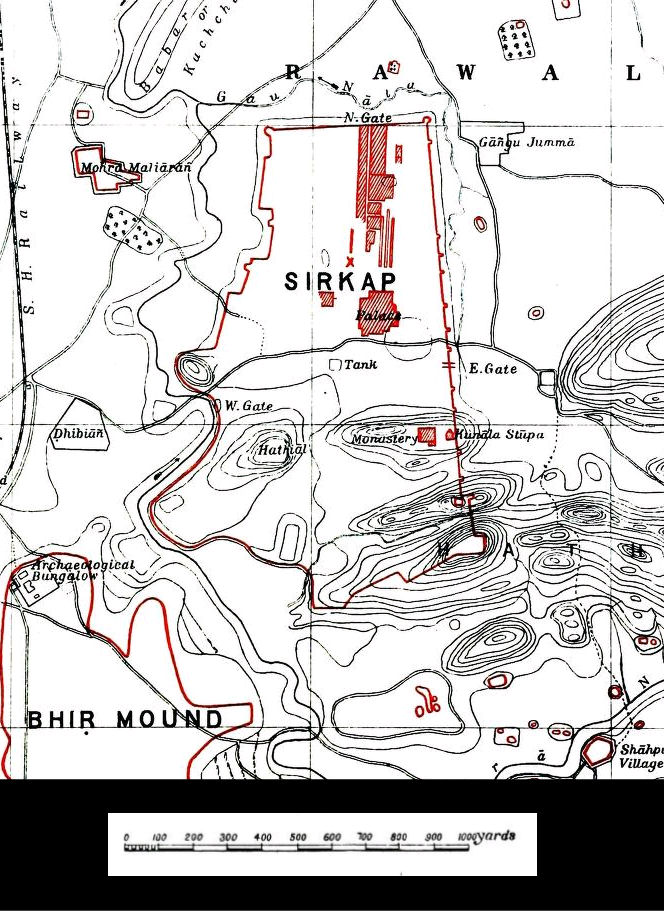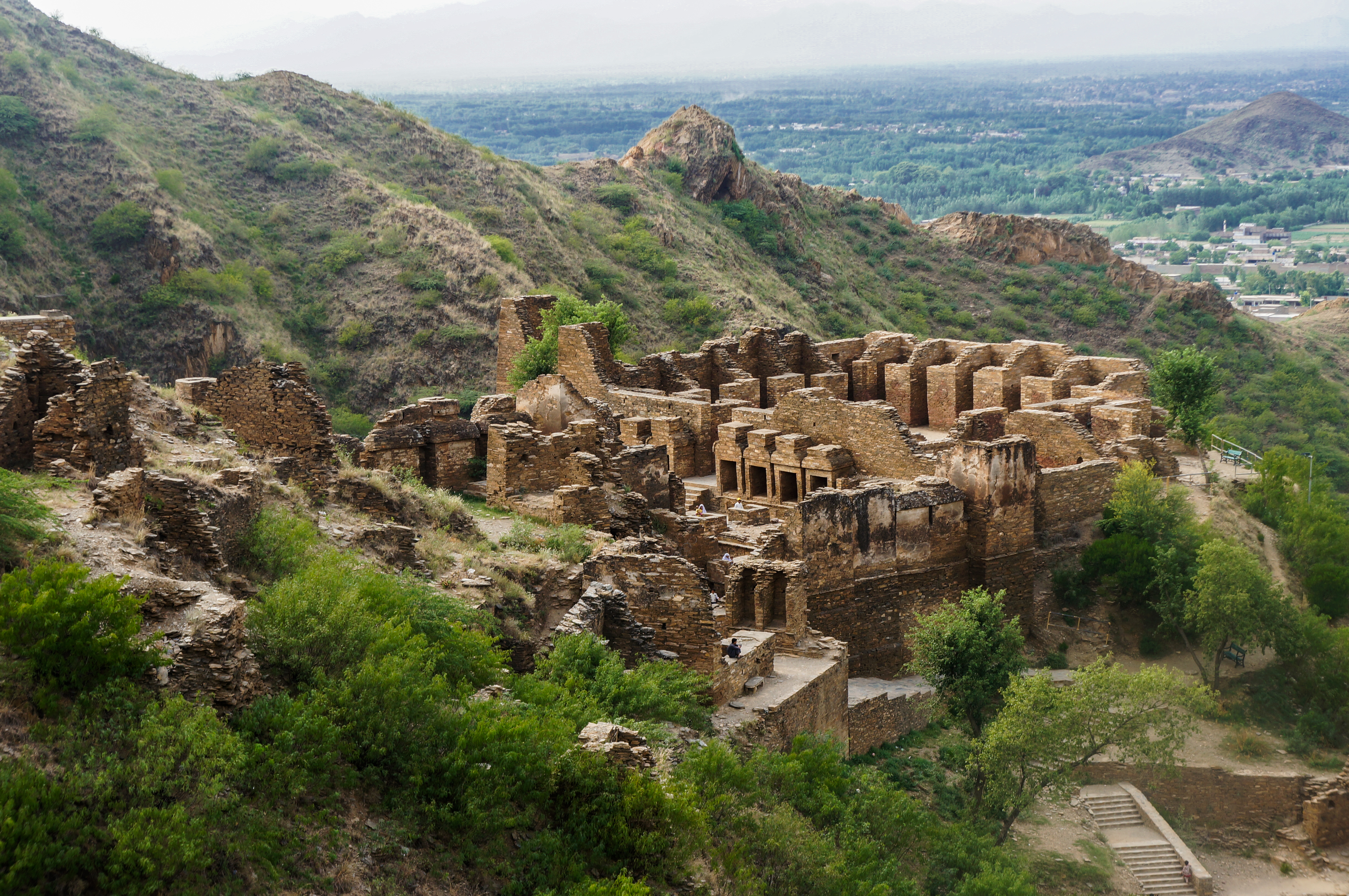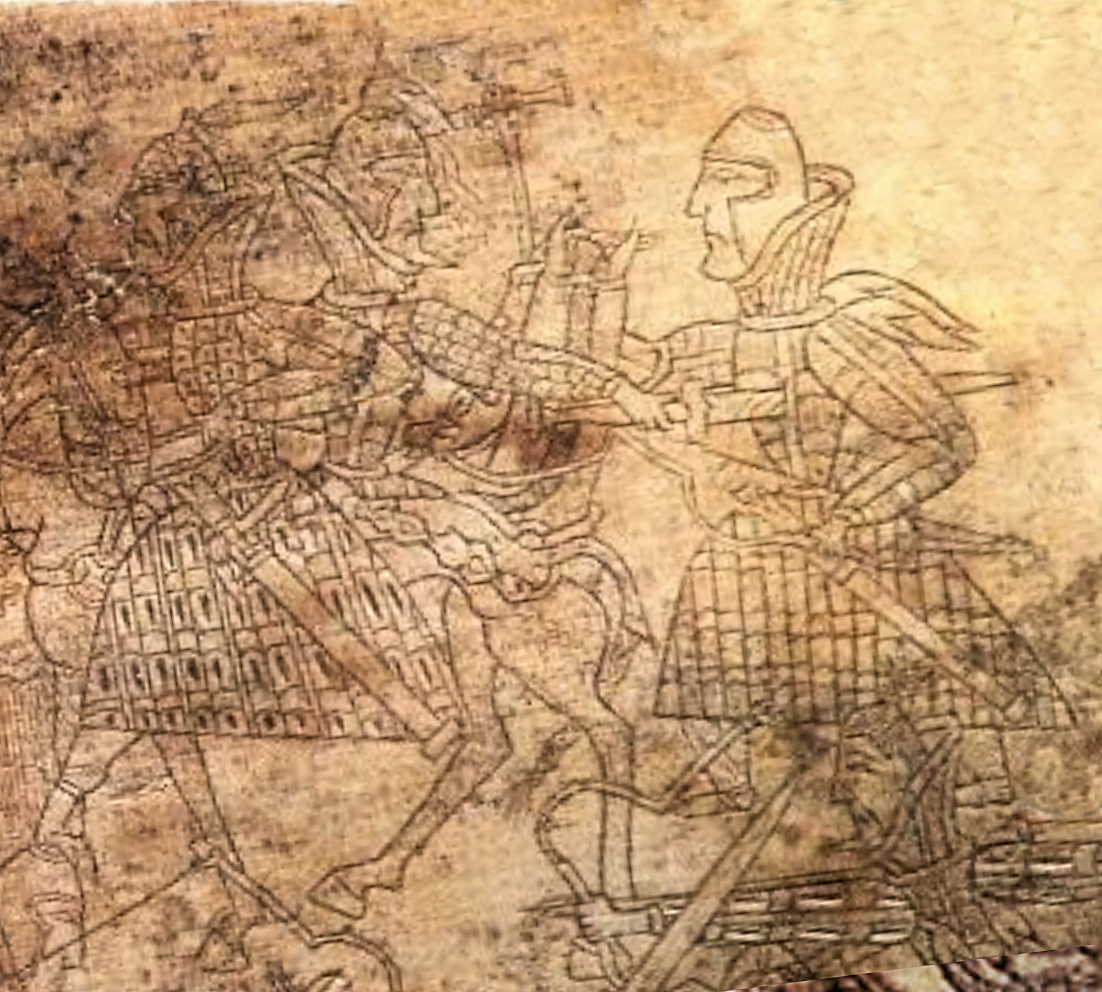|
Sirkap
Sirkap (Urdu and pnb, ) is the name of an archaeological site on the bank opposite to the city of Taxila, Punjab, Pakistan. The city of Sirkap was built by the Greco-Bactrian king Demetrius after he invaded modern-day Pakistan around 180 BC. Demetrius founded an Indo-Greek kingdom that was to last until around 10 BC. Sirkap is also said to have been rebuilt by king Menander I. Archaeological excavations The excavation of the old city was carried out under the supervision of Sir John Marshall by Hergrew from 1912–1930. In 1944 and 1945 further parts were excavated by Mortimer Wheeler and his colleagues. Most of the discoveries at Sirkap related to the Indo-Scythian and Indo-Parthian periods (1st-2nd century CE). Overall excavations to the Greek levels have been very limited, and probably much remains hidden underground: in Sirkap, only about one eight of the excavations were made down to the Indo-Greek and early Indo-Scythian levels, and this only in an area far removed f ... [...More Info...] [...Related Items...] OR: [Wikipedia] [Google] [Baidu] |
Taxila
Taxila or Takshashila (; sa, तक्षशिला; pi, ; , ; , ) is a city in Punjab, Pakistan. Located in the Taxila Tehsil of Rawalpindi District, it lies approximately northwest of the Islamabad–Rawalpindi metropolitan area and is just south of the Haripur District of Khyber Pakhtunkhwa. In 326 BCE, Alexander the Great gained control of the city without a battle, as it was immediately surrendered to him by Omphis. Old Taxila was an important city of ancient India, situated on the eastern shore of the Indus River—the pivotal junction of the Indian subcontinent and Central Asia;Raymond Allchin, Bridget Allchin''The Rise of Civilization in India and Pakistan''.Cambridge University Press, 1982 p.127 it was founded around 1000 BCE. Some ruins at Taxila date to the time of the Achaemenid Persian Empire, followed successively by the Maurya Empire, the Indo-Greek Kingdom, the Indo-Scythians, and the Kushan Empire. Owing to its strategic location, Taxila has cha ... [...More Info...] [...Related Items...] OR: [Wikipedia] [Google] [Baidu] |
Sirsukh
Sirsukh ( ur, سر سکھ) is an ancient city that forms part of the ruins at Taxila, near the modern day city of Taxila, Punjab, Pakistan. City The city of Sirsukh is said to have been founded during the Kushan era after 80 CE, and is the last of the great ancient cities of Taxila. The invaders decided to abandon the older city of Sirkap and build a newer city on the other side of the Lundi-nala. The wall of the city is about 5 kilometers long and about 5.4 meters thick. The city wall covers an area of around 2300 x 1000 meters seen along the east-west direction, and is laid out in a typical Central Asian style, complete with suburbs. Sirsukh was left uninhabited when the White Huns invaded the Punjab at the end of the fifth century CE. To the north-east of the city flows the Harro river whereas to the south the Lundi-ravine is present. The ancient city was excavated only on a very small scale in 1915-16 CE, and further excavation work has been impeded by a high water table whic ... [...More Info...] [...Related Items...] OR: [Wikipedia] [Google] [Baidu] |
Indo-Parthian Kingdom
The Indo-Parthian Kingdom was a Parthian kingdom founded by Gondophares, and active from 19 CE to c. 226 CE. At their zenith, they ruled an area covering parts of eastern Iran, various parts of Afghanistan and the northwest regions of the Indian subcontinent (most of modern Pakistan and parts of northwestern India). The rulers may have been members of the House of Suren, and the kingdom has even been called the "Suren Kingdom" by some authors. The kingdom was founded in 19 when the governor of Drangiana (Sakastan) Gondophares declared independence from the Parthian Empire. He would later make expeditions to the east, conquering territory from the Indo-Scythians and Indo-Greeks, thus transforming his kingdom into an empire. The domains of the Indo-Parthians were greatly reduced following the invasions of the Kushans in the second half of the 1st. century. They managed to retain control of Sakastan, until its conquest by the Sasanian Empire in c. 224/5. In Baluchistan, the Parat ... [...More Info...] [...Related Items...] OR: [Wikipedia] [Google] [Baidu] |
Indo-Parthians
The Indo-Parthian Kingdom was a Parthian kingdom founded by Gondophares, and active from 19 CE to c. 226 CE. At their zenith, they ruled an area covering parts of eastern Iran, various parts of Afghanistan and the northwest regions of the Indian subcontinent (most of modern Pakistan and parts of northwestern India). The rulers may have been members of the House of Suren, and the kingdom has even been called the "Suren Kingdom" by some authors. The kingdom was founded in 19 when the governor of Drangiana (Sakastan) Gondophares declared independence from the Parthian Empire. He would later make expeditions to the east, conquering territory from the Indo-Scythians and Indo-Greeks, thus transforming his kingdom into an empire. The domains of the Indo-Parthians were greatly reduced following the invasions of the Kushans in the second half of the 1st. century. They managed to retain control of Sakastan, until its conquest by the Sasanian Empire in c. 224/5. In Baluchistan, the ... [...More Info...] [...Related Items...] OR: [Wikipedia] [Google] [Baidu] |
Indo-Parthian
The Indo-Parthian Kingdom was a Parthian kingdom founded by Gondophares, and active from 19 CE to c. 226 CE. At their zenith, they ruled an area covering parts of eastern Iran, various parts of Afghanistan and the northwest regions of the Indian subcontinent (most of modern Pakistan and parts of northwestern India). The rulers may have been members of the House of Suren, and the kingdom has even been called the "Suren Kingdom" by some authors. The kingdom was founded in 19 when the governor of Drangiana (Sakastan) Gondophares declared independence from the Parthian Empire. He would later make expeditions to the east, conquering territory from the Indo-Scythians and Indo-Greeks, thus transforming his kingdom into an empire. The domains of the Indo-Parthians were greatly reduced following the invasions of the Kushans in the second half of the 1st. century. They managed to retain control of Sakastan, until its conquest by the Sasanian Empire in c. 224/5. In Baluchistan, the P ... [...More Info...] [...Related Items...] OR: [Wikipedia] [Google] [Baidu] |
Bhir Mound
The Bhir Mound ( ur, ) is an archaeological site in Taxila in the Punjab province of Pakistan. It contains some of the oldest ruins of Ancient Taxila, dated to sometime around the period 800-525 BC as its earliest layers bear "grooved" Red Burnished Ware, the Bhir Mound, along with several other nearby excavations, form part of the Ruins of Taxila – inscribed as a UNESCO World Heritage Site in 1980. Context The Bhir Mound archaeological remains represent one stage of the historic city of Taxila. The first town in Taxila was situated in the Hathial mound in the southwest corner of the Sirkap site. It lasted from the late second millennium BC until the Achaemenid period, with the Achaemenid period remains located in its Mound B. The Bhir Mound site represents the second city of Taxila, beginning in the pre-Achaemenid period and lasting till the early Hellenistic period. The earliest occupation on the Bhir mound began around 800-525 BC, and what now appears to be the second ... [...More Info...] [...Related Items...] OR: [Wikipedia] [Google] [Baidu] |
Hathial
Hathial is an ancient archaeological site next to Bhir Mound, just south of Sirkap, in the area of Taxila in Pakistan. It is quite a large site, in which red burnished ware and various materials were discovered similar to those of Charsadda. This suggest that the establishment of the Hathial site may go back as far as 1000 BCE. The adjoining settlement of Bhir Mound was only created later, probably around 500 BCE. The pottery found at the site has been dated to the period between 1000 BCE and 400 BCE, and thus constitute an interesting intermediary, pre-Achaemenid period, between the Late Harappan of the Indus Valley The Indus ( ) is a transboundary river of Asia and a trans-Himalayan river of South and Central Asia. The river rises in mountain springs northeast of Mount Kailash in Western Tibet, flows northwest through the disputed region of Kashmir, ... and the Early Historic period. References Bibliography * * * {{Archaeological sites in Taxila , state=expa ... [...More Info...] [...Related Items...] OR: [Wikipedia] [Google] [Baidu] |
Indo-Scythians
Indo-Scythians (also called Indo-Sakas) were a group of nomadic Iranian peoples of Scythian origin who migrated from Central Asia southward into modern day Pakistan and Northwestern India from the middle of the 2nd century BCE to the 4th century CE. The first Saka king of India was Maues/Moga (1st century BCE) who established Saka power in Gandhara, Pakistan and the Indus Valley. The Indo-Scythians extended their supremacy over north-western India, conquering the Indo-Greeks and other local kingdoms. The Indo-Scythians were apparently subjugated by the Kushan Empire, by either Kujula Kadphises or Kanishka. Yet the Saka continued to govern as satrapies, forming the Northern Satraps and Western Satraps. The power of the Saka rulers started to decline in the 2nd century CE after the Indo-Scythians were defeated by the Satavahana emperor Gautamiputra Satakarni. Indo-Scythian rule in the northwestern Indian subcontinent ceased when the last Western Satrap Rudrasimha III wa ... [...More Info...] [...Related Items...] OR: [Wikipedia] [Google] [Baidu] |
Indo-Scythian
Indo-Scythians (also called Indo-Sakas) were a group of nomadic Iranian peoples of Scythian origin who migrated from Central Asia southward into modern day Pakistan and Northwestern India from the middle of the 2nd century BCE to the 4th century CE. The first Saka king of India was Maues/Moga (1st century BCE) who established Saka power in Gandhara, Pakistan and the Indus Valley. The Indo-Scythians extended their supremacy over north-western India, conquering the Indo-Greeks and other local kingdoms. The Indo-Scythians were apparently subjugated by the Kushan Empire, by either Kujula Kadphises or Kanishka. Yet the Saka continued to govern as satrapies, forming the Northern Satraps and Western Satraps. The power of the Saka rulers started to decline in the 2nd century CE after the Indo-Scythians were defeated by the Satavahana emperor Gautamiputra Satakarni. Indo-Scythian rule in the northwestern Indian subcontinent ceased when the last Western Satrap Rudrasimha ... [...More Info...] [...Related Items...] OR: [Wikipedia] [Google] [Baidu] |
Indo-Greek
The Indo-Greek Kingdom, or Graeco-Indian Kingdom, also known historically as the Yavana Kingdom (Yavanarajya), was a Hellenistic-era Greek kingdom covering various parts of Afghanistan and the northwestern regions of the Indian subcontinent (parts of modern-day Pakistan and northwestern India). This kingdom was in existence from ca. 200 BC to ca. 1 BC. During its existence the kingdom was ruled over by 30 successive kings. Menander I, being the most well known amongst the Indo-Greek kings, is often referred to simply as ''“Menander,”'' despite the fact that there was indeed another Indo-Greek King known as Menander II. Menander I's capital was at Sagala in the Punjab (present-day Sialkot). The kingdom was founded when the Graeco-Bactrian king Demetrius (and later Eucratides) invaded India from Bactria in 200 BC. The Greeks in the Indian Subcontinent were eventually divided from the Graeco-Bactrians centered on Bactria (now the border between Afghanistan and Uzbe ... [...More Info...] [...Related Items...] OR: [Wikipedia] [Google] [Baidu] |
Greco-Bactrian
The Bactrian Kingdom, known to historians as the Greco-Bactrian Kingdom or simply Greco-Bactria, was a Hellenistic-era Greek state, and along with the Indo-Greek Kingdom, the easternmost part of the Hellenistic world in Central Asia and the Indian Subcontinent from its founding in 256 BC by Diodotus I Soter to its fall BC under the reign of Heliocles I. It covered much of present-day Afghanistan, Uzbekistan, Tajikistan and Turkmenistan, and at its zenith, parts of Iran and Pakistan. An extension further east with military campaigns may have reached central Gansu province in China. Bactria was ruled by the Diodotid dynasty and rival Euthydemid dynasty. The capitals of Ai-Khanum and Bactra were among the largest and richest of antiquity - Bactria itself was known as the ‘''land of a thousand golden cities’''. The Indo-Greek Kingdoms, as Bactrian successor states, would last until 10 AD. History Independence and Diodotid dynasty Diodotus, the satrap of Bactria (and proba ... [...More Info...] [...Related Items...] OR: [Wikipedia] [Google] [Baidu] |








